What Is A Ski Lift Called? The Different Types To Recognize
by Frank V. Persall
When you go to one of the many ski areas scattered around North America and across the globe, one of the most common structures you will see is the ski lift. But this isn’t always the name that immediately springs to mind, so if you’ve been wondering what another name for a ski lift is, you’re in the right place. So, what is a ski lift called you asked?
When thinking about types of ski lift, one of the most easily recognized is the chairlifts that are seen in ski resorts everywhere. But these are far from being the only kind of ski lift and depending on where you are skiing, and the requirements of the resort, you may see various types of ski lifts.
In this guide, we are going to be looking at the various types of lifts you might use as well as what they are designed for. So strap in and let’s get going.
Contents

The Different Types Of Ski Lifts
Chairlift
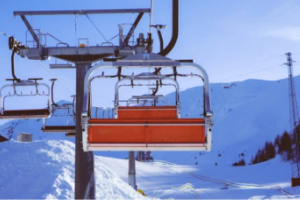
Chairlifts are a common feature in a lot of modern ski resorts. While they are one of the newer versions of the ski lift, they can reach dizzying heights and are frequently found in ski areas with larger mountains.
What’s even better is that chairlifts tend to have a very generous capacity and heated seats. You’ll normally find these types of ski lift with either six or eight seats. Moreover, some of the most modern high-speed systems can transport as many as 4000 passengers every hour making them very convenient.
Depending on where you are skiing, you may see different types of chairlifts. For example, one of the most famous worldwide installations was a fixed-grip chairlift in Hintertux in the mid-’90s. However, more recently, the very first 8-seater chairlift was installed in 2002 which also featured a weather cover since these are not normally enclosed ski lifts.
Gondola Lifts
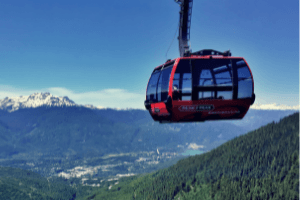
You will likely have seen the gondola ski lifts in operation as they are used as feeder lifts around various attractions particularly where tourist centers are located. One of the greatest things about the gondola ropeway system is that it has a very good capacity of around 20 and is ideal for older people and families. It is also extremely comfortable and easy to mount. Moreover, the gondola is an enclosed ski lift that protects passengers from adverse weather.
While these aren’t the most high-speed detachable lifts, they do offer ease of use as passengers board thanks to a secure coupling system.
Magic Carpet
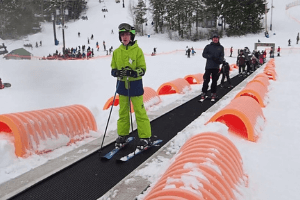
Probably one of the simplest yet effective types of ski lift, the magic carpet is more traditionally known as the surface lift. Surface lifts work in the same style as a conveyor belt and are installed so that the passengers remain in contact with the ground.
The skiers attach to the lift using a belt and the motion of the moving belts transports them up the hill. Compared to other similar types of lifts, the magic carpet is much easier to use and better for less experienced skiers. Moreover, they can only be used over short distances and do not travel at very high speeds.
Cable Car
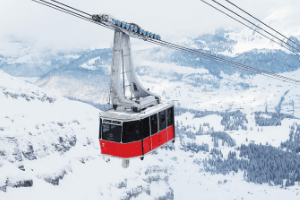
Cable cars are ski lifts that are incredibly similar to the gondola as they both operate on a system of overhead cables. However, where the gondola operates on a rotating system, cable cars move back and forwards on a single cable.
Rope Tow
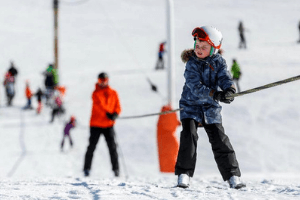
Considered to be the epitome of simplicity, the rope tow was the very first type of ski lift ever used. Before this, if you wanted to ski, you had to make your way up the mountain on foot. You could be forgiven for thinking that this wasn’t the most reliable method of ascent but you’d be wrong.
The rope tow might be primitive but it is quick and effective. This design relies on the passenger taking hold of the rope which runs on a pulley system, drawing them up the slope with their skis touching the ground.
Funicular
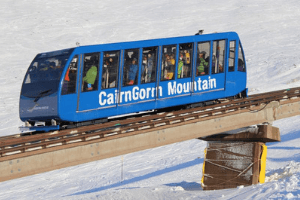
One of the biggest advantages of the funicular system is that these high-speed ski lifts can transport large numbers of passengers every hour. They can travel up to 14 meters per second and very much resemble a train over a traditional ski lift.
These are very robust systems that suffer very little interference from windy or unstable weather conditions. While a traditional train would be powered by an engine, the funicular system works on a haul rope which is typically reversible so that the car can move in both directions.
T-Bars
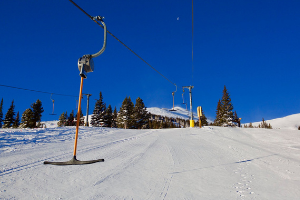
You might have seen the T-bar lift before as it is a common method of getting up the mountain. However, while they may look simple, these are one of the more difficult ski lifts to master.
They feature a T-bar ‘seat’ but unlike other types of a skiing chair lift, the T-bar isn’t designed for sitting and more for support. Much like other types of systems, this one hoists the skier up the mountain with their skis in contact with the ground the entire time.
Frequently Asked Questions
How Does A Ski Lift Work?
Each ski lift type is slightly different from the next, but in the main, they all operate on the same system.
The lifts are tethered to an overhead cable which is powered by a motor. As the engine runs, the cables move, thus drawing the lifts up the mountain. The cables are made from steel and are mounted at the bottom of the system.
How High Are Ski Lifts From The Ground?
No two ski lifts are set at the same height, it very much depends on where you are skiing. Some skiers report having ridden ski lifts that are more than 150ft from the ground. However, normally, they are anywhere between 10 and 75 feet high.
The height must be high enough to clear things on the ground including other skiers.
How To Build A Ski Lift?
The first ski lifts were certainly not as complex as the ones we are seeing in ski areas today but building a simple ski lift does require a lot of innovation and planning.
To get the large concrete columns up the mountain, ski lift builders require the assistance of helicopters; they simply couldn’t move such cumbersome objects any other way.
But what’s more impressive is that rather than using radio communication, builders rely on a series of hand signals to direct where they want the columns!
Summary On What Is A S
You may have been racking your brains for the ski lift name you once heard someone talking about. But in truth, no two ski lifts are the same and they all have different names. The type of lift you will use will vary from resort to resort and while some are incredibly simple and primitive, others boast technological advances that are pretty new to the slopes.
In any case, planning your next skiing trip will involve looking at how you will get up the mountain because your skiing experience will depend on which lifts are most suitable for you.
Related Posts:
 |
 |
 |
 |

About Frank V. Persall
Frank is originally from the UK, but he has a passion for skiing that knows no bounds. He has made it his life's mission to visit the best ski resorts across the USA and the World. Frank loves spending time with his wife and three children on ski slopes, as they all share his love for the activity.
Thoughts on "What Is A Ski Lift Called? The Different Types To Recognize"
 |
 |
 |
 |
You can get FREE Gifts. Or latest free skiing books here.
Disable Ad block to reveal all the info. Once done, hit a button below
 |
 |
 |
 |